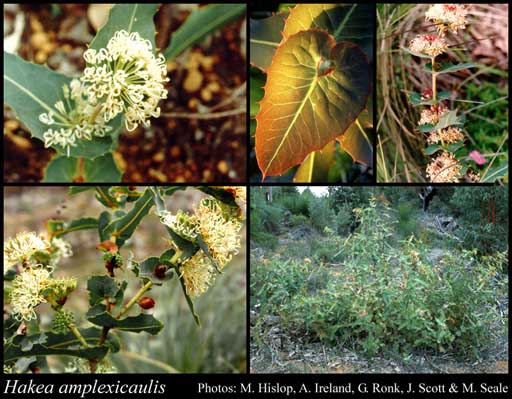- Reference
- Trans.Linn.Soc.London 10:184 (1810)
- Conservation Code
- Not threatened
- Naturalised Status
- Native to Western Australia
- Name Status
- Current
Erect, slender, lignotuberous shrub, 1-3 m high. Fl. white/cream-pink, Aug to Oct. Clay, loam, gravel, laterite.

Scientific Description
Shrubs, 1-3 m high; branchlets glabrous. Leaves alternate, 65-200 mm long, 20-65 mm wide, glabrous; lamina flat, widest around the middle, once divided, pinnately divided, shallowly divided. Inflorescences axillary, white or pink; pedicels 6-14 mm long. Perianth 4-6 mm long, glabrous; ovary glabrous; pistil 8-14.5 mm long, pollen presenter oblique, style glabrous. Follicles 30-35 mm long, 12-15 mm wide, corky tetrahedral projections (on external surfaces of fruit) absent; seed 26-30 mm long (including wing), 9-11 mm wide, the wing discontinuous, marginal or apical, extending down one lateral side only. Flowers in August, September or October. Occurs in the South-west (SW) Botanical Province(s), in the Swan Coastal Plain (SWA), Jarrah Forest (JF), Mallee (MAL), Warren (WAR) or Esperance Plains (ESP) IBRA subregion(s).
Distribution
- IBRA Regions
- Jarrah Forest, Mallee, Swan Coastal Plain, Warren.
- IBRA Subregions
- Northern Jarrah Forest, Perth, Southern Jarrah Forest, Warren, Western Mallee.
- IMCRA Regions
- Leeuwin-Naturaliste, WA South Coast.
- Local Government Areas (LGAs)
- Albany, Armadale, Augusta Margaret River, Beverley, Bridgetown-Greenbushes, Busselton, Capel, Chittering, Cockburn, Collie, Dardanup, Denmark, Donnybrook-Balingup, Gnowangerup, Gosnells, Harvey, Kalamunda, Manjimup, Mundaring, Murray, Nannup, Plantagenet, Serpentine-Jarrahdale, Waroona, York.